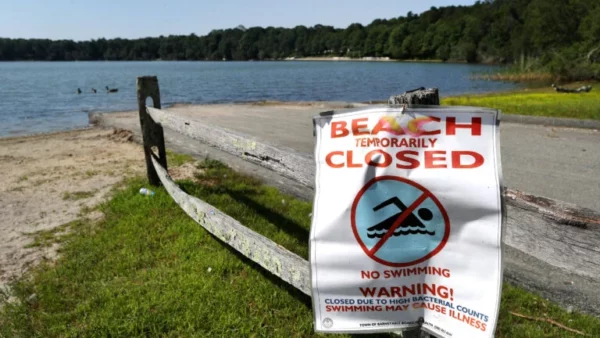
The Maine PFAS Task Force had the chance to take bold action to protect us from toxic "forever" chemicals but its recommendations to Governor Mills miss the mark, leaving our drinking water – and our health – vulnerable. Photo: Symonenko Viktoriia viaShutterstock
Most Mainers first learned of the dangers posed by PFAS chemicals two years ago, when news broke that milk from Arundel’s Stoneridge Farm was contaminated with them. The likely culprit: sludge spread on the farm as fertilizer.
That troubling news spurred state agencies to take steps to safeguard us from these widely used yet dangerous chemicals, which harm humans and the environment. Since then, the state has been performing limited testing of farms, farm products, and water supplies, which shows additional contamination exists in Maine. In addition, the Legislature passed a law requiring PFAS to be phased out of food packaging, and Governor Mills convened a PFAS Task Force to develop further recommendations for action.
Despite these efforts, however, much work remains to be done to protect Mainers from PFAS contamination. The task force recently released a draft of its recommendations, and they fall well short of the bold action that is needed.
As seen in the recent blockbuster film Dark Waters, and as we’ve highlighted, science shows that PFAS chemicals may increase the risk of cancer, inhibit growth and learning in children, and interrupt thyroid function, among other devastating health impacts. They are often referred to as “forever” chemicals because they remain in our bloodstream and environment for decades. These chemicals pose an imminent danger because they are widely used in everyday household products and have already contaminated water sources in Maine.
That’s why we are continuing our push for greater protections from these unsafe pollutants.
Maine’s PFAS Task Force Missed a Key Opportunity to Advance Protections
We were encouraged when Governor Mills convened the PFAS Task Force in March 2019, especially because the Environmental Protection Agency has abdicated its responsibility to address this toxic pollution at the federal level. The task force’s charge was threefold: identify the extent of PFAS exposure in Maine, examine the risks they pose to residents and the environment, and recommend state approaches to most effectively address those risks.
In November 2019, the task force issued its draft recommendations. In reviewing them, we determined that they needed to be stronger to protect people and the environment effectively. Here are the main areas where the task force missed the mark:
- It failed to recommend a drinking water standard for PFAS, which would have set a maximum level for these toxic chemicals in our drinking water, protecting us from additional exposure.
- It recommended that some, but not all, public water systems be tested for PFAS contamination. This means that some of our water will likely remain untested. Given that the Maine Centers for Disease Control and Prevention found recently that 9 out of 19 public water supplies contained PFAS at levels considered harmful to human health, anything short of 100% testing is not good enough.
- It failed to recommend testing sites, including farms, where sludge has been spread historically, meaning that many farms and farm products that may be contaminated will likely go untested. This is despite recent tests by the Maine Department of Environmental Protection that revealed that 31 out of 32 sludge producers and 14 out of 15 compost producers exceeded the state’s level for one or more PFAS.
CLF pushed the task force to correct these failings, but ultimately, in December, the body adopted its draft recommendations, with only slight modifications. We again urged the Task Force to strengthen its recommendations, in particular, the adoption of the statewide drinking water standard. However, given the wide range of interests represented on the Task Force, the group was unable to agree on a recommended standard. It
Even if Governor Mills implements every recommendation made by the task force, Mainers will still be at risk from the harms caused by these hazardous pollutants. Fortunately, however, we have other opportunities for addressing this growing public health threat, and we will be pushing the Legislature and the relevant agencies to take action.
Opportunities Remain to Protect Mainers from the Dangers of PFAS
In 2020, there will be several opportunities for legislative and regulatory action on PFAS pollution in Maine. For instance, the Department of Environmental Protection (DEP) is introducing a bill to the state Legislature, LR 3002, that will seek to amend the state’s Uncontrolled Hazardous Substance Sites law. The amendment will give the state the authority to require the removal and treatment of PFAS when they are a danger to public health. It will also allow the state to use money in the uncontrolled substance sites fund to clean up PFAS contamination. CLF will be working to ensure that DEP gains this additional authority funding stream to help clean up contaminated sites.
Further, DEP is currently considering a new policy to designate PFOS – one of the PFAS class of chemicals – as a priority chemical under Maine’s Kids Safe Products ActCLF submitted comments in favor of this change, but also called for it to apply to other forms of PFAS. We will continue to participate in this process, including a public hearing on the rule changes on January 23 of this month.
As these and other activities unfold in Maine, we will continue to advocate for stronger protections for humans and the environment from the serious risks posed by PFAS “forever” chemicals.



